

In May 2018 I discovered another Cast Iron monument that Garton & King can lay claim to having produced so I have added this latest discovery to the top of the list. I may yet discover others!
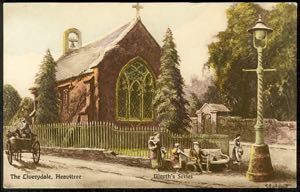 Any motorist or pedestrian in the Livery Dole area of Heavitree, Exeter must be familiar with the monument near St Claires Chapel at the junction with Heavitree Road, Fore Street Heavitree and Magdalen Road where is strategically placed what is known by most as the Gordon Lamp. It is here that on the small triangle of paving is a safe haven for pedestrians venturing to cross these always busy roads.
Any motorist or pedestrian in the Livery Dole area of Heavitree, Exeter must be familiar with the monument near St Claires Chapel at the junction with Heavitree Road, Fore Street Heavitree and Magdalen Road where is strategically placed what is known by most as the Gordon Lamp. It is here that on the small triangle of paving is a safe haven for pedestrians venturing to cross these always busy roads.
The history of the monument is displayed on a nearby plaque and much information is available on http://www.exetermemories.co.uk/em/_places/liverydole.php on Wikipedia and also on the Exeter Civic Society’s website. It was the Civic Society and others who were responsible for its restoration in 2015.
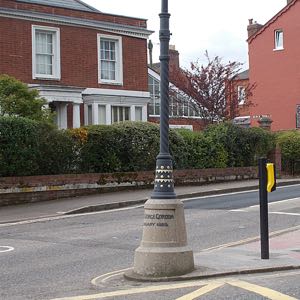
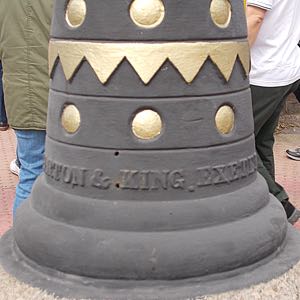 The Lamp Column itself is the most distinctive part of the memorial and up until the 18th May 2018 the manufacturer of the cast iron was completely ignored or overlooked by those who have put the history of this Memorial into print. I can now rectify this and proudly state it was cast by Garton & King at their Waterbeer Street Foundry just yards away from the Guildhall in 1884/1885 and plainly displays the words as shown in the image, GARTON & KING, EXETER. It was originally a Gas Lamp but like so many artefacts in Exeter the ‘modernists’ couldn’t resist getting their sticky fingers on it and the ‘T’ shaped ladder support has disappeared and it has had its Barley Twist column unceremoniously extended to raise the now electric light higher up in the air. Can’t ‘they’ ever leave anything alone without tampering with history, and a Monument to boot!
The Lamp Column itself is the most distinctive part of the memorial and up until the 18th May 2018 the manufacturer of the cast iron was completely ignored or overlooked by those who have put the history of this Memorial into print. I can now rectify this and proudly state it was cast by Garton & King at their Waterbeer Street Foundry just yards away from the Guildhall in 1884/1885 and plainly displays the words as shown in the image, GARTON & KING, EXETER. It was originally a Gas Lamp but like so many artefacts in Exeter the ‘modernists’ couldn’t resist getting their sticky fingers on it and the ‘T’ shaped ladder support has disappeared and it has had its Barley Twist column unceremoniously extended to raise the now electric light higher up in the air. Can’t ‘they’ ever leave anything alone without tampering with history, and a Monument to boot!
Quite when this lamp post was erected is not recorded. The Prebendary Barnes, onetime Vicar of Heavitree, was a close friend of General Gordon and, on the death of the General on the 26th January 1885, arranged and paid for this memorial; however searching the British Newspaper archive failed to come up with any details of the unveiling ceremony or when it took place, which one imagines at that time was a significant event for Heavitree people, My searching only discovered two mentions of the Gordon Lamp.
The first relates to Primrose Day, Monday 19th April 1886 (Primrose Day commemorates the death of Benjamin Disraeli), when a wreath of primroses was laid at the memorial, and the second submitted by 'Churchman' to a local newspaper on the 5th April 1887 where he comments on the poor Gas Lighting at the entrance to Exeter Cathedral. In his letter to the paper he makes comparison between the Cathedral Lighting and the Gordon Lamp. He states "Why do not they fix, (at the Cathedral) say, four lamps, with two powerful jets a-piece, the same as those put up at Livery Dole in memory of General Gordon, the Khartoum hero?"
Of course nowadays the illumination offered by the Lamp is by electricity, but the description offered as to the original gas light specification is of interest.
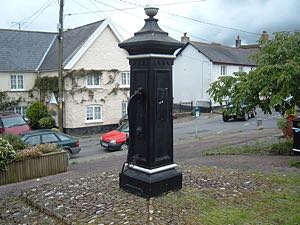
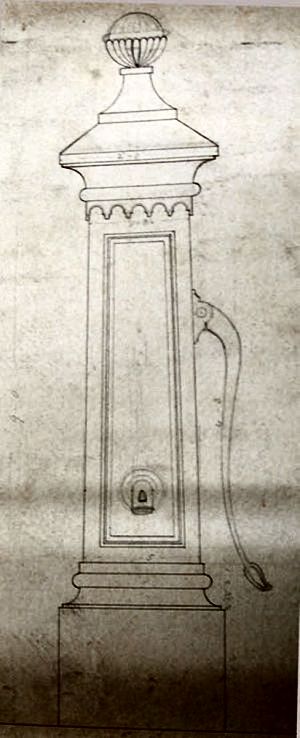 CHITTLEHAMPTON is a small village about 8 miles south east of Barnstaple and to the north east of Umberleigh. The principal feature of its large Main Square is the Decorative Water Pump on the South side.
CHITTLEHAMPTON is a small village about 8 miles south east of Barnstaple and to the north east of Umberleigh. The principal feature of its large Main Square is the Decorative Water Pump on the South side.
This Pump was manufactured in the days of Garton & Jarvis - a surviving manufacturers plate, there were originally two, states ‘Garton & Jarvis, Manufrs, Exeter’.
The Chittlehampton Pump is a source of puzzlement to me. As yet no-one has provided evidence as to the provider of this pump, or its cost or when it was erected. The last point can be narrowed down to between 1851 and 1865. No earlier than 1851 as that is when Garton & Jarvis, the manufacturer and whose foundry cast it, were awarded the Royal ‘By Appointment’ as shown on the nameplate. No later than 1865 as that is when the company became Garton & King on the death of Ambrose Parker Jarvis. Royal Jubilees were unheard of in Victorian times – the 25 years of Victoria’s reign – 1862 – was barely 2 months after Prince Albert’s death – at that time Victoria was not exactly in the mood for celebration anyway. The first Monarch ever to have an organised Commemorative Silver Jubilee was King George V in 1935.
The care and attention to the pump’s appearance also fluctuates. Early black & white images show it in varying degrees of neglected appearance. Moving into the Glorious Technicolour Era shows firstly a rather revolting Primrose and White (hardly heavy metal colours), suggestions perhaps of a Hippie Flower Power Influence and nowadays the morbid and dreary predominately Black suggests a belated gesture to Prince Albert’s death or Victoria’s passing in 1901. The Black, of course, could be simply down to a B & Q 50% off sale!
One of the nameplates on the pump is damaged but otherwise the Pump, although no longer in use, appears in reasonable condition. The design drawing is from G & K’s Archives but is unfortunately undated and there is no evidence in the Company Records as to who actually ordered the Pump, exactly when, why or how much it cost. A British Newspaper Library search has also failed to provide any information and similarly the Parish Council, in spite of their best efforts, have also drawn a blank. One other point, and this MAY be because of different angles taken by photographers over the years (but I think not) the Pump seems to have been moved to various locations within the square over its 156 year minimum lifetime.
For an edifice that has been a Grade 11 Listed Building since January 1988, Reference No 1258425 it seems that within the village and environs not much is known about its History or Donor.
June 2021
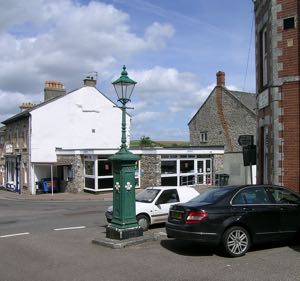 COLYTON in East Devon, a Devon mile north of Colyford and the A3052 boasts a fine Ornamental Fountain and Lamp located at the junction of Market Place, South Street, Queen Street and South Square. It was probably ordered and installed in the very early days of Garton & King (1865 onwards) though the monies for it were raised in March 1863 in the era of Garton & Jarvis so there’s a degree of fluidity as to its precise date.
COLYTON in East Devon, a Devon mile north of Colyford and the A3052 boasts a fine Ornamental Fountain and Lamp located at the junction of Market Place, South Street, Queen Street and South Square. It was probably ordered and installed in the very early days of Garton & King (1865 onwards) though the monies for it were raised in March 1863 in the era of Garton & Jarvis so there’s a degree of fluidity as to its precise date.
The lamp on top appears not to be part and parcel of the original fountain as it is secured in place by four straps and to my eyes looks somewhat unwieldy. I hope the lamp still works - perhaps some Colyton Resident will let me know, it’s a shame the Fountain Portion doesn’t. Should we blame South West Water for this I wonder - it seems that few operational Fountains, Village Pumps or even Horse Troughs survive in working order - certainly none of Exeter’s Horse troughs do.
 HELE PAPER MILL.The final Monument is again a Water Feature but unfortunately no longer exists but there are doubtless some that will remember it, perhaps a photograph of the Mill Entrance exists which may include it? Compilation drawing/photo courtsey of Warwick Knowles, Bradninch.
HELE PAPER MILL.The final Monument is again a Water Feature but unfortunately no longer exists but there are doubtless some that will remember it, perhaps a photograph of the Mill Entrance exists which may include it? Compilation drawing/photo courtsey of Warwick Knowles, Bradninch.
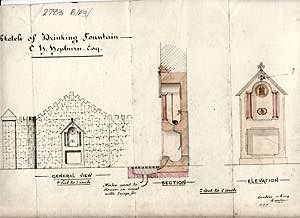 Here is a drawing from the archives.
Here is a drawing from the archives.
It was erected by C Hepburn Esquire, of Dunmore House, Bradninch and onetime owner of Hele Paper Mill, possibly in 1888 and maybe to commemorate the death of H T Hepburn of that same year. The mock up image shows its probable location. It was removed in the 1960s - perhaps it ended up as a water feature in someone’s garden - many a true word is spoken in jest - if it still exists I’d love to know as it obviously was a work of art as well as serving a useful purpose.
See also:
Railings — Gates — Grave Markers
Illumination — Mixed Bag — Oddities
Sitemap / Contents